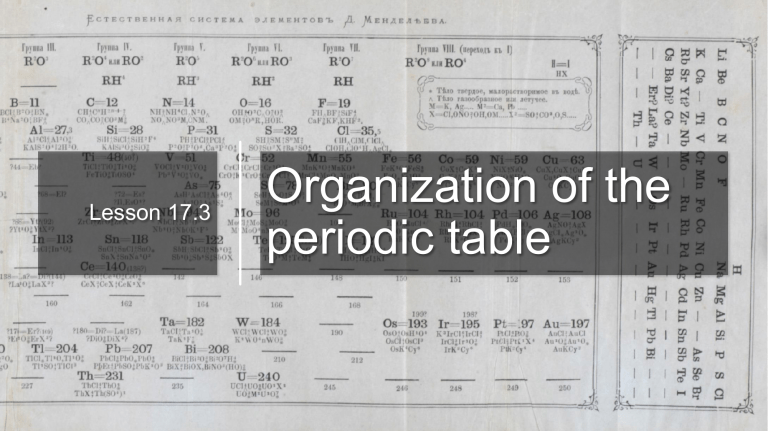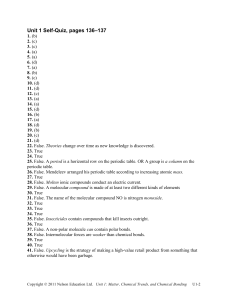lesson 4N
advertisement

Lesson 17.3 Organization of the periodic table Organization of the periodic table • Describe atomic radius and how it is arranged on the periodic table • Explore the characteristics of common members of the major groups on the periodic table • Recognize the three types of chemical bonds STEM STEM 17.3 402 -406 09/01/2019 Organization of the periodic table • Describe atomic radius and how it is arranged on the periodic table • Explore the characteristics of common members of the major groups on the periodic table • Recognize the three types of chemical bonds 17.3 402 -406 09/01/2019 Originality VR lab (The Periodic table) Organization of the periodic table • Describe atomic radius and how it is arranged on the periodic table • Explore the characteristics of common members of the major groups on the periodic table • Recognize the three types of chemical bonds 17.3 402 -406 09/01/2019 Originality Organization of the periodic table • Describe atomic radius and how it is arranged on the periodic table • Explore the characteristics of common members of the major groups on the periodic table • Recognize the three types of chemical bonds 17.3 402 -406 09/01/2019 Originality Organization of the periodic table • Describe atomic radius and how it is arranged on the periodic table • Explore the characteristics of common members of the major groups on the periodic table • Recognize the three types of chemical bonds 17.3 402 -406 09/01/2019 Originality Organization of the periodic table • Describe atomic radius and how it is arranged on the periodic table • Explore the characteristics of common members of the major groups on the periodic table • Recognize the three types of chemical bonds 17.3 402 -406 09/01/2019 Originality Organization of the periodic table • Describe atomic radius and how it is arranged on the periodic table • Explore the characteristics of common members of the major groups on the periodic table • Recognize the three types of chemical bonds 17.3 402 -406 09/01/2019 Originality Organization of the periodic table 09/01/2019 Originality • Describe atomic radius and how it is arranged on the periodic table • Explore the characteristics of common members of the major groups on the periodic table • Recognize the three types of chemical bonds 17.3 402 -406 Many transition metals are excellent catalysts that can be added to a reaction to increase the reaction rate without getting consumed in the process. Ex: combines hydrogen and nitrogen to make ammonia using an iron catalyst. Organization of the periodic table • Describe atomic radius and how it is arranged on the periodic table • Explore the characteristics of common members of the major groups on the periodic table • Recognize the three types of chemical bonds 17.3 402 -406 09/01/2019 Originality Organization of the periodic table • Describe atomic radius and how it is arranged on the periodic table • Explore the characteristics of common members of the major groups on the periodic table • Recognize the three types of chemical bonds 17.3 402 -406 09/01/2019 Originality Organization of the periodic table 09/01/2019 Originality • Describe atomic radius and how it is arranged on the periodic table • Explore the characteristics of common members of the major groups on the periodic table • Recognize the three types of chemical bonds 17.3 402 -406 All the noble gases are colorless and odorless. Assignment Organization of the periodic table • Describe atomic radius and how it is arranged on the periodic table • Explore the characteristics of common members of the major groups on the periodic table • Recognize the three types of chemical bonds 17.3 402 -406 09/01/2019 Originality Organization of the periodic table • Describe atomic radius and how it is arranged on the periodic table • Explore the characteristics of common members of the major groups on the periodic table 09/01/2019 Chemical bonds • There are three characteristic types of chemical bonds though many bonds have varying degrees of electron interaction. • Recognize the three types of chemical bonds 17.3 402 -406 Originality Ionic bond Organization of the periodic table • Describe atomic radius and how it is arranged on the periodic table 09/01/2019 Chemical bonds • Explore the characteristics of common members of the major groups on the periodic table • Recognize the three types of chemical bonds 17.3 402 -406 covalent bond Originality Organization of the periodic table • Describe atomic radius and how it is arranged on the periodic table 09/01/2019 Chemical bonds • Explore the characteristics of common members of the major groups on the periodic table • Recognize the three types of chemical bonds 17.3 402 -406 metallic bond Originality Organization of the periodic table • Describe atomic radius and how it is arranged on the periodic table • Explore the characteristics of common members of the major groups on the periodic table • Recognize the three types of chemical bonds 17.3 402 -406 09/01/2019 Originality Chemical bonds • There are three characteristic types of chemical bonds though many bonds have varying degrees of electron interaction. Test your knowledge 1. What group characteristics make the noble gases unique? Test your knowledge 1. What group characteristics make the noble gases unique? The noble gases are mostly inert; they don’t react with other elements very readily because they have a full outer shell of electrons. Test your knowledge 2. Why are the atoms of group 1 elements so much larger than the atoms of group 17 elements? Test your knowledge 2. Why are the atoms of group 1 elements so much larger than the atoms of group 17 elements? Atoms in group 1 have a smaller positive charge in their nucleus, so they attract their electron cloud less strongly and the electron cloud is further away Test your knowledge 3. What are some of the characteristics that make transition metals unique? Test your knowledge 3. What are some of the characteristics that make transition metals unique? Many transition metals can have more than one charge in an ionic compound. Also, many transition metals work to make other chemical reactions easier. Test your knowledge 4. What makes the halogens so reactive? Test your knowledge 4. What makes the halogens so reactive? Group 17 is reactive because it is so close to group 18. The elements in group 17 attract an extra electron very strongly. Test your knowledge 5. What is the difference between the 3 types of bonds? Test your knowledge 5. What is the difference between the 3 types of bonds? The difference is in how electrons are distributed among atoms in the bonds. Electrons are transferred from one atom to another in an ionic bond, electrons are shared between atoms in a covalent bond, and electrons are shared by all atoms in a metallic bond.



